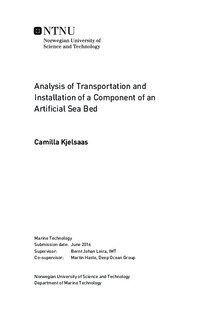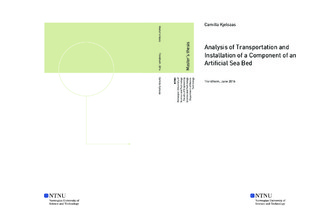| dc.description.abstract | The purpose of this Master's Thesis was to study the transportation and installation of a bundle component to be used in an Artificial Seabed. The bundle, which is composed of three pipes and close to 4 km in length, is to be transported through the Sognefjord and installed as a connection between Lavik and Oppedal. The towing method that is to be used is the Controlled Depth Tow Method (CDTM). The CDTM involves towing an object in an immersed condition, which will avoid critical parts such as lift-off of deck and lowering of objects through the splash zone. The analyses in this study is divided into two parts, one for transportation and one for installation.The transportation over the North Sea is not included in this study, as it is a well known procedure used in the offshore industry. However, towing of long slender structures through a fjord has not been conducted before. The bundle length exceeds the width of the fjord, which makes the installation procedure challenging.
The computer program Sima Riflex is used for analyzing slender marine structures, and is utilized in this study. The finite element method is used for solving the structural analyses in Sima Riflex. For the dynamic analysis, the response of the system is found when it is exposed to a predefined sea state. Sima Riflex has different approaches for solving nonlinear systems, including nonlinear time domain analysis, linearized time domain analysis and frequency domain analysis. Finally an eigenvalue analysis is conducted for the different models as well, in order to show how the structure will behave when exposed to dynamic loading.
The bundle geometry is simplified to a circular pipe with properties corresponding to the original shape for the modeling in Sima Riflex. Both the towing and the installation models consist of the bundle with one towing wire and towing tug connected at each end point. Additional towing tugs have been applied as horizontal forces. The environmental conditions that are used are based upon studies of the Sognefjord conducted by SINTEF.
The transportation process is divided into three scenarios with different sea states, as to cover the towing through the different parts of the fjord. In order to maneuver the bundle through the turns of the fjord, it might be necessary to bend it. Therefore, two of the scenarios include a parameter study of the degree of bending of the bundle.
The installation process is also divided into three scenarios, where each represents a possible installation approach. The first scenario conduct the installation by only curving the bundle using the horizontal plane. The second scenario do the same by only using the vertical plane for installation, thus lowering the bundle into the depth of the fjord. The final scenario utilizes a combination of both planes for the installation.
The active modes of the bundle during transportation in Sognefjord have eigenperiods of 2.8 s, which are inside the energetic wave period band. All wave motion is extinguished for the given towing depth, indicating that the responses are not caused by direct wave loads, but due to the motion of the tugs. The low periods indicate that the effect of fatigue damage should be studied closer for the towing operation. For towing through more severe sea states, direct wave loads are not avoided. This will increase the dynamic moments and displacements significantly. Furthermore it is found that the bundle can be curved during transportation, but within certain limits.
For the installation, the scenario that exploits both the horizontal and the vertical space will be the most suitable with respect to magnitude of responses in the bundle and feasibility of operation. Parameter studies of the immersion of the bundle is conducted, and it is found that an immersion of -75 m will give the smallest responses of dynamic displacement without significant increase in moment. Additionally the depth will leave a good distance between the bundle and the undersea borders of the fjord throughout the operation.
As a conclusion, it has been found that the towing through the fjord is feasible, but that direct wave loads should be avoided. An installation procedure that exploits both the horizontal and the vertical plane is found to be most suitable. The active modes during transportation and installation are in the energetic wave period band, and the responses are caused by the motion of the tugs. The sideways position of the bundle during installation will lead to increased responses, but as the active modes are far away from the vortex shedding frequency, VIV is possibly avoided. The responses both during transportation and installation remain below the critical limit, but fatigue damage is of concern and should be studied closer. | en |

